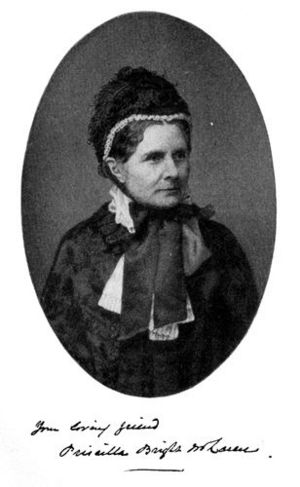Priscilla Bright McLaren facts for kids
Quick facts for kids
Priscilla Bright McLaren
|
|
|---|---|
 |
|
| Born |
Priscilla Bright
8 September 1815 Rochdale, England
|
| Died | 5 November 1906 (aged 91) Edinburgh, Scotland
|
| Nationality | British |
| Education | Hannah Johnson's school in Liverpool |
| Known for | Suffragist and abolitionist |
| Spouse(s) | Duncan McLaren |
| Children | Charles McLaren Helen Priscilla McLaren Walter McLaren |
| Relatives | Jacob Bright (brother) Agnes McLaren (stepdaughter) Margaret Bright Lucas (sister) |
Priscilla Bright McLaren (born September 8, 1815 – died November 5, 1906) was an important British activist. She helped connect the movement to end slavery (called anti-slavery) with the movement for women to get the right to vote (called women's suffrage) in the 1800s. She was a member of the Edinburgh Ladies' Emancipation Society. Later, she became the president of the Edinburgh Women's Suffrage Society.
Biography of Priscilla Bright McLaren
Priscilla Bright was born in Rochdale, England. She came from a Quaker family. Quakers are a religious group who believed in treating everyone equally, including educating girls. Her father, Jacob Bright, started as a weaver and became a rich cotton maker. He had strong beliefs about fairness and passed these ideas to his children.
Priscilla's mother, Martha, was also very involved in the family business. She created groups for her children to write essays and debate. These skills helped Priscilla and her sister, Margaret Bright Lucas, and her famous brother, John Bright, who became a Member of Parliament.
For a while, Priscilla took care of her brother John's house and his daughter, Helen Bright Clark. She thought she might not have her own family. But when John remarried, Priscilla accepted a marriage proposal from Duncan McLaren. He was an Edinburgh merchant who had been married twice before and was quite a bit older than her. Priscilla became a stepmother to his five children.
Duncan McLaren became a successful politician in Edinburgh. He was a city leader and then a Member of Parliament in 1865. Priscilla and Duncan worked together on many campaigns. People at the time said they were "equal partners." They had three children together.
After the Ladies' Emancipation Society ended its work, Eliza Wigham, Jane Wigham, and their friends started the Edinburgh group of the National Society for Women's Suffrage. Priscilla McLaren became the president of this new group. Eliza Wigham and Priscilla's step-daughter, Agnes McLaren, were the secretaries. Elizabeth Pease Nichol was the treasurer.
Priscilla McLaren passed away in Edinburgh on November 5, 1906. She had just shown her support for women who were put in prison for fighting for the right to vote. She was buried next to her husband in St Cuthbert's Kirkyard in Edinburgh.
Priscilla McLaren's Legacy
In 2015, a group of historians in Edinburgh started a campaign to recognize four important women from the city. These women were Priscilla Bright McLaren, Elizabeth Pease Nichol, Eliza Wigham, and Jane Wigham. They called them the city's "forgotten heroines."
Priscilla McLaren's name and picture are also on the base of the statue of Millicent Fawcett in Parliament Square, London. This statue was revealed in 2018 and honors 58 other supporters of women's right to vote.
Images for kids
See also
 In Spanish: Priscilla Bright McLaren para niños
In Spanish: Priscilla Bright McLaren para niños


